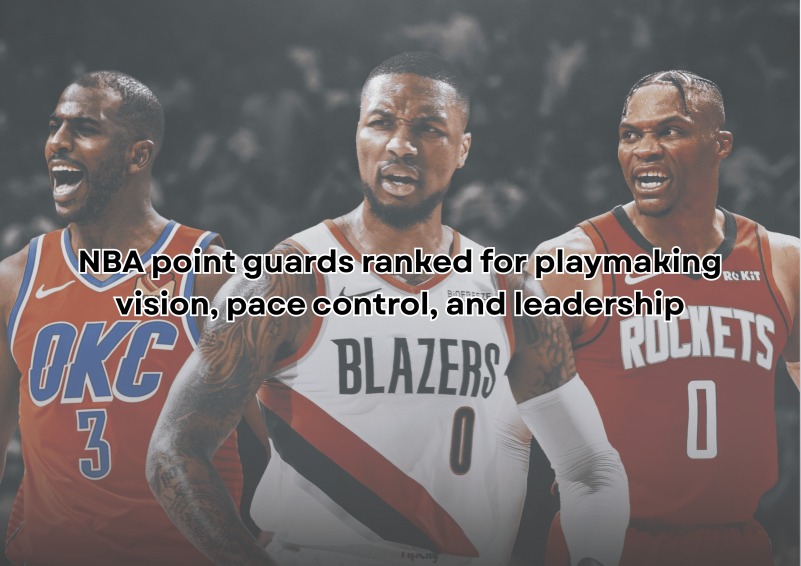
If you care about how a game is really run, you care about NBA point guards. The best NBA point guards do more than bring the ball up and call a set. They decide when the game breathes, when it sprints, and when everyone else just stands in the right place and trusts them.
This list is for fans who want to see the position as more than box scores and mixtapes. These twelve guards saw passing lanes that were not there yet, controlled tempo without looking rushed, and made grown pros fall quiet in huddles. You do not need to agree with every ranking. You just need to feel how much they shaped what a point guard is supposed to be.
Why great point guards matter
The league can get by without a classic low post scorer. It falls apart without somebody who knows where the ball should go and when.
Coaches call the position an extension of themselves. You need ego to demand the ball, and the humility to give it up at the right second. That is playmaking vision, pace control, and leadership.
The best of these guards changed how teams practiced and how opponents prepared. Once you really watch them, you start to notice who actually runs a game now and who just crosses half court and waits.
Methodology: Rankings lean on league stats, official honors, and deep reporting, with peak creation, tempo control, two way value, and trust from teammates and coaches weighed most, and close calls settled by playoff proof and how well each game would still work in another era.
The guards who steer everything
1. Magic Johnson, standard for NBA point guards
Picture that game in Boston in the late nineteen eighties. Magic brings the ball up, glides into the lane, and drops a soft running hook over two big men. The junior sky hook lands, the arena groans, and the series swings. One shot, total command.
Over his career Magic won 5 titles and 3 Most Valuable Player awards, and he averaged 11 point 2 assists per game, the best for a full career. In his prime he lived in double digit assists while scoring near twenty a night for a fast paced Lakers team that ran on his decisions.
2. Oscar Robertson, triple double control room
Here is the thing about Oscar Robertson. In the early nineteen sixties, he averaged a triple double for a full season when there was no three point line and guards took real contact. Thirty plus points, double digit rebounds, double digit assists, from a point guard, night after night.
For his career he put up 25 point 7 points, 7 point 5 rebounds, and 9 point 5 assists per game. Later he slid to Milwaukee, shared the floor with a young Kareem, and helped steer that group to a title. That is a different kind of leadership. First as full engine, then as co pilot who still calls the routes.
3. Stephen Curry, gravity that runs an offense
There is a regular season game in Oklahoma City that still feels wild. Curry crosses half court in overtime with the score tied, takes a couple of light dribbles, and rises from way behind the line. The shot drops. Teammates chase him. The arena looks stunned.
Curry now owns the record for made threes and has 4 titles and 2 Most Valuable Player awards, while living around 6 or 7 assists per night. On paper that looks like a scoring guard line. On the floor, his movement and range open up more easy looks for teammates than most pass first guards ever created. Defenses panic as soon as he turns the corner. That panic is playmaking.
4. Chris Paul, point guard as problem solver
Think about that playoff game in Los Angeles where Paul hit the leaning banker over Tim Duncan on a bad hamstring. He grimaced, then kept directing traffic, still calling sets and pointing teammates where he wanted them. That is what he has done for almost two decades.
Paul sits near the very top of the all time lists in both assists and steals, with more than twelve thousand dimes and over two thousand swipes. At his peak he lived around ten assists and very few turnovers, which meant long stretches where every good shot started with his decision. Add steady scoring in the high teens, and you get a guard who rarely wasted a possession.
5. John Stockton, quiet master of the pick and roll
There is that shot in Houston in the late nineties. Stockton curls to the top, rises for a three, and sends Utah to the Finals. The crowd explodes. He barely cracks a smile. That calm is part of his power.
He still holds the records for both assists and steals, with totals so far ahead of the field that they look like typo numbers. In peak seasons he averaged around thirteen assists while scoring efficiently in the mid teens on more than fifty percent shooting. Those are wild numbers next to modern guards who handle more possessions and still fall short of that blend.
6. Isiah Thomas, fearless voice of the Bad Boys
The image that never fades is that third quarter in Los Angeles. On a badly rolled ankle, Isiah scores twenty five points in a single period against the Lakers in the Finals. He hops, grimaces, and keeps attacking anyway.
Thomas finished with more than nine thousand assists and two rings as the lead guard and emotional engine of the Pistons. In his best seasons he lived near twenty points and ten assists in a league that allowed hand checks and real physical contact on the perimeter. That mix of scoring and playmaking under those rules still jumps out now.
7. Steve Nash, tempo artist with a green light
Picture Nash in Phoenix, dribbling under the basket, never picking the ball up, eyes darting as defenders twist around screens. He waits that extra second, then flips a small pass back over his shoulder for a dunk. The whole possession feels like a little trick.
Nash won two regular season Most Valuable Player awards with the Suns and had stretches where he averaged around eighteen points and ten or eleven assists on absurd shooting splits, flirting with fifty percent from the field, forty from three, ninety from the line. His offenses sat near the top of the league and laid out ideas that almost every modern team now uses.
8. Jason Kidd, rebounding mind in the backcourt
Think back to those early two thousands Nets teams. The rosters were not loaded with stars. They ran anyway. Kidd would grab a long rebound, turn, and fire a pass past midcourt before some bigs had even turned around. That became their fast break system.
Kidd finished with more than twelve thousand assists and over two thousand six hundred steals, along with over one hundred triple doubles. In many seasons he averaged close to ten assists and seven or eight rebounds from the guard spot. That board work let him control tempo without waiting for an outlet.
9. Walt Frazier, cool control in New York noise
Everyone remembers Willis Reed walking out of the tunnel in that famous Knicks Finals game. The box score remembers Frazier dropping thirty six points and nineteen assists and seven rebounds in the same night. He ran everything while the Garden shook.
Frazier led New York to its only two titles and became the franchise assist leader, with seasons near twenty points and six or seven assists, plus top level perimeter defense. He was the link between earlier guards like Robertson and the flashier eighties stars, showing how a point guard could run a team, defend, and still score in big moments.
10. Gary Payton, voice and defense for the whole floor
Most highlight reels start with Payton picking up a guard full court, chest to chest, talking from the first step, then ripping the ball loose. The Glove nickname came from that pressure. In the mid nineteen nineties he became the rare guard to win Defensive Player of the Year.
Payton was not just a stopper, though. He averaged about sixteen points and seven assists and nearly two steals for his career, with seasons near twenty and eight when Seattle needed more scoring. Payton ran high pick and roll, posted smaller guards, and pushed tempo whenever he smelled a mismatch.
11. Luka Doncic, new age point guard on his own terms
For a modern snapshot, go back to that playoff game in Los Angeles where Luka Doncic hit a step back three over a switching big to win it at the buzzer. He beat the clock, stared for a second, then collapsed into teammates. The shot felt like a player saying I am here to stay.
Through his first seasons he has averaged close to a near triple double line, somewhere near high twenties in points with around eight rebounds and eight assists. He runs more pick and rolls than almost anyone, slows and speeds games at will, and uses his size to see over traps and double teams. Compared with most young guards in history, his early command already sits in rare air.
Luka has said he loves having the ball and making decisions. Coaches talk about him calling sets on the fly, reading defenders for a few trips, then hunting exactly the matchup he wants. When you watch late games, you can feel the arena waiting for whatever he decides, even when defenses load every body toward him.
What comes next
If you love this position, the best thing you can do is simple. Watch full games. See who actually talks in huddles, who waves off rushed shots, who pulls a teammate aside after a bad possession.
Then notice how the eras line up. Cousy once pushed the game forward, but Oscar and Frazier turned that early creativity into full control, and Magic blew the whole idea open. Curry, Paul, Nash, and the rest picked up those threads and pulled them into today. Luka is still adding new pages.
Somewhere out there a kid is learning pace by watching all of them and thinking, I can do that a little different.
Which future guard will force us to tear up this list and start again.
Also Read: https://info-vista.com/nba-legends-every-fan-should-know/



